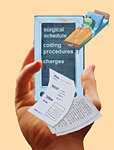

A Microsoft Word version 7.0 of this article can be downloaded to your hard drive.
PDAs can boost productivity, cut paperworkAvailable applications can automate coding, streamline billing, reduce accounts receivables |
 |
By Ian J. Alexander MD
As originally conceived, personal digital assistants (PDAs) were simple tools designed to handle personal information management tasks such as keeping track of appointments, contacts and to-do lists. Today, the term PDA misrepresents the digital power of the latest handheld computers. Current handheld devices pack high-speed processors (200+ MHz), ample memory (up to a gigabyte on a flash card) and wireless connectivity that make them mobile data workhorses.
Harnessing this power with sophisticated software will lead to practice productivity enhancement with a rapid return-on-investment that will drive widespread implementation.
Productivity enhancing applications currently available for these devices include automated ICD-9 and CPT coding, point-of-care charge capture to streamline billing and reduce accounts receivable, wireless data transfer both in the office and from remote locations, electronic prescribing, electronic medical records and customizable research or registry forms. These applications provide the physician a mobile means of accessing and entering patient data, and the added benefits of improved documentation, fewer coding errors, safer prescribing and less "paperwork."
The latter benefit is worth exploring in more detail. Take for example surgical scheduling, often a labor intensive and time consuming secretarial process. Computer-assisted scheduling allows the scheduler to rapidly search for and identify appropriate time slots, automate the scheduling of frequent procedures using macros that include ICD-9 and CPT codes, and electronically transmit the information to the surgical facility. A 20 to 30 minute process can thus be reduced to 2 to 3 minutes. All this information is transferable to the physician’s handheld device.
Thus, at anytime the physician has at his or her fingertips the entire surgical schedule, as well as a means of coding procedures and submitting charges immediately after surgery. In addition, handheld computer-based operative report templates, custom-built by the physician, allow instant generation of a narrative surgical record without dictation.
Despite the significant return-on-investment of point-of-care charge capture, this potential is dwarfed by the savings possible with transition to a "structured" electronic medical record system. Structured means form-based and not free text. Free text electronic records are the computerized equivalent of your current dictated paper record and although they save clerical time and improve record access, financial advantages of this transition will be minimal. Significant saving will only be achieved with structured records, which, in contrast to free text records, make possible:
If dictation is needed, carrying a separate voice recording device isn’t necessary as some handheld devices are capable of capturing audio files. These recordings can be entered into the note fields of any form and subsequently transcribed into the record.
Although physicians have the most to gain through improved efficiency and lower overhead, it’s their resistance to change that most often hinders information technology adoption. However, a well thought out implementation plan can soften resistance by making the process minimally disruptive. First, start with a "champion," a visionary computer-savvy physician who appreciates the potential long-term benefit and will take ownership of the project. Second, choose a software package that allows gradual implementation, starting with charge capture and progressing to an EMR as each physician becomes comfortable with using handheld devices. Third, make sure the system allows for a parallel paper record during the transition and accommodates physicians who insist on dictating their records.
In the final analysis a carefully planned implementation of orthopaedic surgery specific PDA-based charge capture and documentation systems will minimize practice disruption, reduce risk and maximize potential benefits.
By Ian J. Alexander MD FRCS(C) is an orthopaedic surgeon and president of Aristar Inc., an Ohio software company that develops handheld computer applications for orthopaedic surgeons.
Computer Link welcomes suggestions about future topics for the column and questions about the use of computers in orthopaedic practice. Send your suggestions to the Bulletin at AAOS, 6300 N. River Rd., Rosemont, Ill. 60018 or e-mail breisch@aaos.org
![]()
![]()